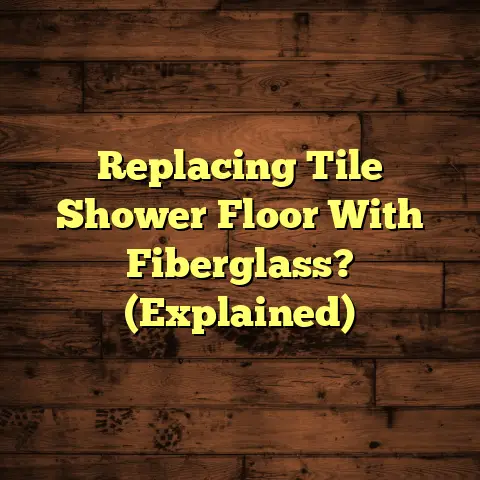Prep Plywood For Vinyl? (4 Steps To Success!)
Ever had one of those DIY projects that spiraled out of control faster than a runaway train? I remember a homeowner, let’s call him Bob, who was super pumped to install vinyl flooring in his basement. He envisioned a sleek, modern space, perfect for family movie nights.
Bob skipped a few “minor” steps, thinking he could save time. Big mistake! The vinyl started bubbling within weeks, and the edges were lifting like they were trying to escape. Moisture got trapped underneath, and before you knew it, the plywood was starting to rot.
The whole project turned into a costly nightmare. Bob learned the hard way that prepping plywood for vinyl isn’t just a suggestion; it’s the foundation for a successful, long-lasting flooring job.
Let me tell you, I’ve seen it all in my years as a flooring contractor. And believe me, taking the time to do it right from the start saves you a whole lot of headaches (and money) down the road. So, let’s dive into the four essential steps to prepping plywood for vinyl!
1. Understanding the Importance of Preparation
Why all the fuss about prepping plywood? Think of it like this: your vinyl flooring is only as good as the surface underneath. If that surface is uneven, dirty, or damp, your vinyl is doomed.
Proper preparation is like building a solid foundation for a house. It prevents future problems, extends the life of your flooring, and ensures a professional-looking finish that you can be proud of. I cannot stress enough how important this step is.
Here’s what can happen if you skip the prep:
- Uneven Surfaces: Bumps and dips in the plywood will show through the vinyl, making your floor look lumpy and unprofessional.
- Moisture Issues: Plywood is susceptible to moisture damage. If it’s not properly sealed, moisture can seep in and cause the wood to warp, rot, or even grow mold.
- Adhesive Failure: Vinyl adhesives need a clean, smooth surface to bond properly. Dirt, dust, or old adhesive residue can interfere with the bond, causing the vinyl to lift or bubble.
According to the Resilient Floor Covering Institute (RFCI), proper subfloor preparation is essential for a successful vinyl flooring installation. They estimate that over 50% of flooring failures are due to inadequate subfloor preparation. That’s a staggering number, and it highlights just how important this step is.
I’ve seen homeowners try to cut corners and regret it later. Don’t be one of them! Taking the time to prep your plywood properly is an investment in the long-term beauty and durability of your vinyl flooring.
2. Step 1: Assessing the Plywood Substrate
Alright, let’s get down to business. The first step is to thoroughly assess your plywood subfloor. This is where you become a flooring detective, looking for any signs of trouble.
Here’s what you need to look for:
- Damage: Check for cracks, gouges, or delamination (where the layers of plywood are separating). Any significant damage needs to be repaired or replaced.
- Warping: Use a long level or straightedge to check for warping. Warped plywood can create unevenness in your finished floor.
- Moisture Content: This is crucial! Plywood should have a moisture content of no more than 12% before you install vinyl. Use a moisture meter to check this. You can find these at most home improvement stores. If the moisture content is too high, you’ll need to address the source of the moisture and allow the plywood to dry completely before proceeding.
Tips for Assessing Plywood:
- Use a bright light: A strong light will help you spot any imperfections in the plywood surface.
- Run your hand over the surface: Feel for any bumps, dips, or rough spots.
- Pay attention to edges and corners: These areas are often the most susceptible to damage and moisture.
- Sniff around: A musty or moldy smell is a sign of moisture problems.
Plywood Thickness and Quality:
The thickness and quality of your plywood also play a role in the success of your flooring project. For most vinyl flooring applications, I recommend using plywood that is at least 3/4 inch thick. Thicker plywood provides a more stable and rigid base for your vinyl.
As for quality, look for plywood that is rated for flooring use. This type of plywood is typically made with a higher-quality adhesive and is less likely to warp or delaminate. Common types include:
- AC Plywood: One side is sanded smooth (A grade) and the other side has minor defects (C grade). This is a good option if you only need one smooth surface.
- BC Plywood: One side has minor defects (B grade) and the other side has more significant defects (C grade). This is a more economical option, but you’ll need to make sure the better side is facing up.
According to the APA – The Engineered Wood Association, using the correct grade and thickness of plywood is essential for ensuring the structural integrity of your floor. They have detailed guidelines on plywood selection for different flooring applications. It’s worth checking out their website for more information: https://www.apawood.org/
If your plywood is damaged, warped, or has a high moisture content, you’ll need to repair or replace it before moving on to the next step. Don’t try to cut corners here. A solid, stable subfloor is the key to a beautiful and long-lasting vinyl floor.
3. Step 2: Cleaning the Surface
Okay, detective work is done! Now it’s time to clean up the crime scene, so to speak. A clean plywood surface is essential for proper adhesive bonding. Any dirt, dust, or debris can interfere with the bond and cause your vinyl to lift or bubble.
Here’s what you’ll need:
- Broom or Shop Vacuum: For removing loose dirt and debris.
- Scraper: For removing any stuck-on residue or old adhesive.
- Damp Cloth or Mop: For wiping down the surface and removing any remaining dirt.
- Mild Detergent (optional): For stubborn stains or grime.
- Mineral Spirits (optional): For removing old adhesive residue.
The Cleaning Process:
- Sweep or Vacuum: Start by removing all loose dirt and debris from the plywood surface. Pay attention to corners and edges, where dust tends to accumulate.
- Scrape Away Residue: Use a scraper to remove any stuck-on residue, such as paint splatters, dried glue, or bits of old flooring. Be careful not to damage the plywood surface.
- Damp Wipe: Dampen a cloth or mop with clean water and wipe down the entire plywood surface. If you have stubborn stains or grime, you can add a mild detergent to the water. Be sure to wring out the cloth or mop well to avoid getting the plywood too wet.
- Remove Old Adhesive: If you have old adhesive residue on the plywood, you can try removing it with mineral spirits. Apply the mineral spirits to a clean cloth and rub the residue until it softens. Then, scrape it away with a scraper. Be sure to ventilate the area well when using mineral spirits.
- Let it Dry: Allow the plywood to dry completely before moving on to the next step. This may take several hours, depending on the humidity and temperature.
Dealing with Existing Adhesives:
Removing old adhesive can be a real pain, but it’s essential for a smooth, even surface. Here are a few tips:
- Test a small area first: Before applying mineral spirits or any other solvent to the entire surface, test it in a small, inconspicuous area to make sure it doesn’t damage the plywood.
- Use a heat gun: A heat gun can help soften old adhesive, making it easier to scrape away. Be careful not to overheat the plywood, as this can damage it.
- Rent a floor scraper: For large areas with stubborn adhesive, you may want to consider renting a floor scraper from a local tool rental shop. These machines can make quick work of removing old adhesive.
I always recommend using a HEPA-filtered vacuum for cleaning up dust and debris. This helps prevent the dust from becoming airborne and causing respiratory problems. According to the EPA, dust from construction and remodeling projects can contain harmful substances, such as lead and asbestos. Using a HEPA-filtered vacuum can help protect your health.
Once the plywood is clean and dry, you’re ready to move on to the next step: leveling the surface.
4. Step 3: Leveling the Plywood
Alright, we’ve got a clean slate to work with. Now, let’s make sure that slate is perfectly flat! An uneven plywood surface will telegraph through your vinyl flooring, creating unsightly bumps and dips. Leveling the plywood is crucial for achieving a seamless, professional-looking installation.
Here’s what you’ll need:
- Long Level or Straightedge: For checking for levelness.
- Self-Leveling Compound: For filling in low spots and creating a smooth, level surface.
- Sanding Block or Floor Sander: For sanding down high spots.
- Wood Filler: For filling in small holes and imperfections.
- Trowel or Spreader: For applying self- leveling compound.
Checking for Levelness:
Start by using a long level or straightedge to check for levelness across the entire plywood surface. Place the level in different directions and look for any gaps between the level and the plywood. Mark any high or low spots with a pencil.
Leveling Methods:
There are two main methods for leveling plywood:
- Self-Leveling Compound: This is a pourable liquid that spreads out and self-levels, filling in low spots and creating a smooth, even surface. It’s ideal for larger areas with significant unevenness.
- Sanding: This involves sanding down high spots to create a more level surface. It’s best for smaller areas with minor unevenness.
Using Self-Leveling Compound:
- Prepare the Surface: Make sure the plywood is clean and dry. You may need to prime the plywood with a special primer designed for use with self-leveling compound. This will help the compound bond to the plywood.
- Mix the Compound: Follow the manufacturer’s instructions for mixing the self-leveling compound. Be sure to use the correct amount of water and mix thoroughly to avoid lumps.
- Pour the Compound: Pour the self-leveling compound onto the plywood surface, starting in the lowest area. Use a trowel or spreader to spread the compound evenly and ensure that it fills in all the low spots.
- Let it Dry: Allow the self-leveling compound to dry completely before moving on to the next step. This may take several hours or even overnight, depending on the humidity and temperature.
Sanding High Spots:
- Identify High Spots: Use a long level or straightedge to identify any high spots on the plywood surface.
- Sand the High Spots: Use a sanding block or floor sander to sand down the high spots until they are level with the surrounding surface. Be careful not to sand too much, as this can create low spots.
- Fill in Holes and Imperfections: Use wood filler to fill in any small holes or imperfections in the plywood surface. Allow the wood filler to dry completely before sanding it smooth.
I always recommend using a moisture meter to check the moisture content of the self- leveling compound before installing vinyl flooring. The compound should be completely dry before you proceed, or you risk moisture problems later on. Most self-leveling compounds have a maximum moisture content of around 5%.
According to a study by the National Wood Flooring Association (NWFA), proper subfloor leveling can increase the lifespan of your flooring by as much as 20%. That’s a significant increase, and it highlights the importance of taking the time to do it right.
Once the plywood is level and smooth, you’re ready to move on to the final step: sealing and priming (if necessary).
5. Step 4: Sealing and Priming the Plywood (if necessary)
We’re in the home stretch! Sealing and priming the plywood is the final step in preparing it for vinyl flooring. This step is not always necessary, but it’s highly recommended, especially in moisture-prone areas like bathrooms, kitchens, and basements.
Why Seal and Prime?
- Moisture Protection: Sealing the plywood helps to prevent moisture from seeping into the wood, which can cause it to warp, rot, or grow mold.
- Improved Adhesion: Priming the plywood creates a smooth, uniform surface that the vinyl adhesive can bond to more effectively.
- Prevent Staining: Priming can also help to prevent stains from the plywood from bleeding through the vinyl flooring.
When is Sealing and Priming Necessary?
- Moisture-Prone Areas: As mentioned earlier, sealing and priming are essential in areas that are exposed to moisture.
- Damaged Plywood: If the plywood has any damage, such as cracks or gouges, sealing and priming can help to protect it from further damage.
- Plywood with Knots or Grain: Plywood with a lot of knots or grain can be more difficult to get a smooth, even surface. Priming can help to fill in these imperfections.
Choosing the Right Primer and Sealant:
- Primer: Look for a primer that is specifically designed for use with vinyl flooring. These primers are typically acrylic-based and provide excellent adhesion.
- Sealant: Look for a sealant that is waterproof and mildew-resistant. Polyurethane sealants are a good choice for plywood.
The Application Process:
- Clean the Surface: Make sure the plywood is clean and dry before applying the primer or sealant.
- Apply the Primer: Use a brush, roller, or sprayer to apply the primer to the plywood surface. Apply a thin, even coat and allow it to dry completely before moving on to the next step. Follow the manufacturer’s instructions for drying times.
- Apply the Sealant (if necessary): If you’re sealing the plywood, apply the sealant in the same way as the primer. Apply a thin, even coat and allow it to dry completely before moving on to the next step. Follow the manufacturer’s instructions for drying times.
I always recommend using a high-quality primer and sealant. These products may cost a bit more, but they will provide better protection and adhesion. Don’t skimp on this step!
According to the U.S. Department of Housing and Urban Development (HUD), proper sealing and priming can help to prevent moisture problems and extend the life of your flooring. They have detailed guidelines on moisture control in buildings, which you can find on their website: https://www.hud.gov/
Once the primer and sealant (if used) are completely dry, you’re finally ready to install your vinyl flooring!
Conclusion
So, there you have it: the four essential steps to prepping plywood for vinyl flooring. It might seem like a lot of work, but trust me, it’s worth it in the long run.
Let’s recap:
- Assess the Plywood Substrate: Look for damage, warping, and moisture.
- Clean the Surface: Remove all dirt, dust, and debris.
- Level the Plywood: Fill in low spots and sand down high spots.
- Seal and Prime (if necessary): Protect the plywood from moisture and improve adhesion.
Remember Bob, the homeowner from the beginning of this article? He learned the hard way that skipping these steps can lead to a flooring disaster. Don’t make the same mistake!
Taking the time to properly prepare your plywood subfloor will not only ensure a beautiful and long-lasting vinyl floor, but it will also save you time, money, and frustration in the long run.
There’s nothing quite like the feeling of stepping back and admiring a job well done. When you take the time to do it right, you can be proud of your work for years to come. So, get out there and start prepping that plywood! You got this!





